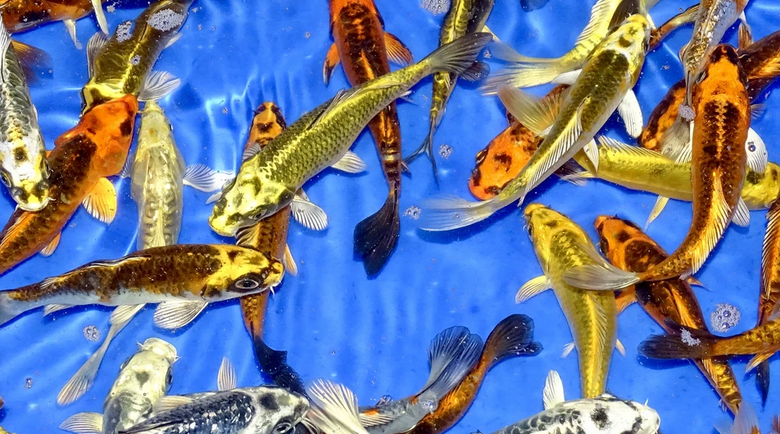
Everything you need to know about Ghost Koi
When it comes to Ghost Koi, we often get asked questions from customers such as: What are they? Can they be kept with normal Koi? Why are they great value? What do they eat?
Their name is quite accurate, as there does seem to be a level of mystery surrounding them. So, we will attempt to answer some of the above questions and provide a detailed, but simple guide to help you understand everything you need to know about Ghost Koi fish.
Check out our range of Koi For Sale, click here.
What is a Ghost Koi?
Ghost Koi were first conceived in the 1980’s, when Koi Carp bred with more naturally coloured wild carp (mirror or common carp). The end result was fish which are characterised by many of the traits of true Koi Carp (Nishikigoi) but with dark scales down the back and often dark markings on the face and body.
In 1980’s Japan when Koi farmers came across such fish, they would be culled on account of being undesirable. While Ghost Koi were often almost fully black in the 80’s, the present-day versions are much more colourful, coming in both scaled and scale-less (doitsu) varieties; and as a result, have become a staple feature in many Koi ponds worldwide. We can thank Koi pioneering countries such as Israel, for the beautiful specimens we see today.
Ghost Koi are genetically identical to true Nishikigoi. While the wild Amur carp species may have separated from the Koi Carp in looks due to hybridising the two varieties, they’re very much still the same species and are able to produce fertile offspring. One of the key differences other than colour, is Ghost Koi tend to be more voracious, eating more than their counterparts.
How best to look after a Ghost Koi?
Our top tips for looking after Ghost Koi are as follows:
- Feed them well, with high quality food (but not too much). We discuss this in more detail below.
- Look out for any unusual behaviour (clamped fins, heavy breathing, flashing etc.)
- Be proactive with potential issues i.e. Spot them early with regular visual inspections and use targeted treatments accordingly.
- Check your water parameters frequently.
How long do Ghost Koi live?
In terms of lifespan we can expect longevity to be similar to true Koi Carp – typically 30 – 70 years in the UK, although there have been specimens of Koi in much warmer countries which have reportedly lived to over 200 years.
Check out our range of Koi For Sale, click here.
How big do Ghost Koi grow?
In our experiences they grow to the same overall size as Koi Carp, but as stated previously, their voracious feeding habits often cause them to grow much larger quickly.
It isn’t unusual in a pond to see Ghost Koi coming up for food first and consuming the most, which is an instinctive behaviour. Likewise, they will often spend their time patrolling the water surface looking for food making themselves very visible and great to watch.
What do I feed a Ghost Koi?
Check out our range of Koi Food, click here
In terms of dietary requirements, just like Koi they will consume just about anything but are best fed on sustainable foods designed for fish which promote fish health, size and colour.
We would personally recommend either of the following:
Do Ghost Koi eat other fish?
Despite their intimidating name, Ghost Koi are not predatory and will rarely eat other fish.
Can Ghost Koi breed? - When?
Breeding Ghost Koi (or indeed any Koi) in the UK can be a challenge as they prefer more temperate climates for spawning. In order to achieve success, the weather must be appropriately warm.
When the time is right, fish will often seek out heavily planted areas of the pond (or spawning brushes where applicable) – Females will scatter eggs and males will follow up by fertilising these.
Koi will often consume most of their eggs after spawning so it is good practice to remove eggs to a separate brooding tank/pond after spawning or alternatively let nature take its course and hope for survivors.
Are Ghost Koi Hardy?
Given their links to the original wild carp, Ghost Koi are very hardy but as expected, can be affected by ALL fish-based parasites. In our experiences we see fewer health-related problems with Ghost Koi and they seem to cope better with parasitic outbreaks.
This is most likely down to genetic links with strong wild fish – much in the same way pedigree bred dogs tend to come with more health issues than crossbred dogs, due to selective breeding pressures.
How much are Ghost Koi?
Ghost Koi are often much cheaper than true Nishikigoi Koi Carp, as they aren’t classified or recognised as true Koi Carp to zealous Koi hobbyists. This is understandable when you compare them with a show winning Kohaku.
With that said, they are a fantastic addition to any pond, often giving other fish in the pond increased confidence. With Ghost Koi you really do get a lot of bang for your buck – so if you’re after something large, why not consider one for in your pond?